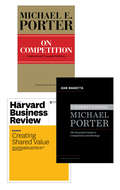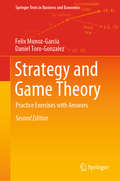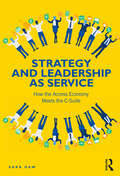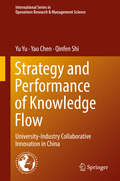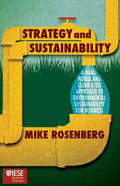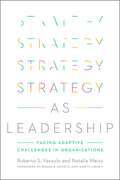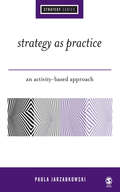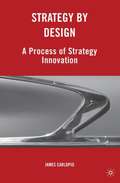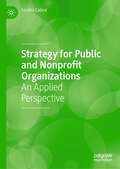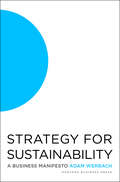- Table View
- List View
Strategy and Competition: The Porter Collection
by Joan Magretta Michael E. Porter Mark R. KramerThis collection highlights the most important ideas and concepts from Michael E. Porter, recognized worldwide as the leading thinker on strategy. Porter heads The Institute for Strategy and Competitiveness based at Harvard Business School and is the foremost authority on competitive strategy for business, as well as on the competitiveness and economic development of nations, states, and regions. Business readers will recognize Porter's seminal book, On Competition, as a classic in the field. This set, curated by Harvard Business Review, includes the full digital edition of the updated and expanded edition of On Competition-a must-have for anyone interested in or studying the topic of strategy and for those developing strategy for their own organizations. The collection also includes the digital edition of the popular Understanding Michael Porter: The Essential Guide to Competition and Strategy, which offers a concise, accessible summary of Porter's revolutionary thinking and was written with Porter's full cooperation by Joan Magretta, his former editor at Harvard Business Review. Finally, the set features the newer foundational article "Creating Shared Value," which was published in Harvard Business Review in 2011 to great fanfare and global accolades. This must-have collection is for anyone serious about business, strategy, and competitiveness.
Strategy and Game Theory: Practice Exercises with Answers (Springer Texts in Business and Economics)
by Felix Munoz-Garcia Daniel Toro-GonzalezThis textbook presents worked-out exercises on game theory with detailed step-by-step explanations. While most textbooks on game theory focus on theoretical results, this book focuses on providing practical examples in which students can learn to systematically apply theoretical solution concepts to different fields of economics and business. The text initially presents games that are required in most courses at the undergraduate level and gradually advances to more challenging games appropriate for graduate level courses. The first six chapters cover complete-information games, separately analyzing simultaneous-move and sequential-move games, with applications in industrial economics, law, and regulation. Subsequent chapters dedicate special attention to incomplete information games, such as signaling games, cheap talk games, and equilibrium refinements, emphasizing common steps and including graphical illustrations to focus students’ attention on the most relevant payoff comparisons at each point of the analysis. In addition, exercises are ranked according to their difficulty, with a letter (A-C) next to the exercise number. This allows students to pace their studies and instructors to structure their classes accordingly. By providing detailed worked-out examples, this text gives students at various levels the tools they need to apply the tenets of game theory in many fields of business and economics. The second edition of the text has been revised to provide additional exercises at the introductory and intermediate level, expanding the scope of the book to be appropriate for upper undergraduate students looking to improve their understanding of the subject. The second edition also includes a new chapter devoted entirely to cheap talk games. Revised to appeal to a larger audience of instructors and students, this text is appropriate for introductory-to-intermediate courses in game theory at the upper undergraduate and graduate levels.
Strategy and Governance at Yahoo! Inc.
by David Lane Krishna G. Palepu Suraj Srinivasan Ian Mckown CornellYahoo! faces a number of governance and strategic challenges in late 2011 as it tries to compete with rivals such as Google and find ways to monetize its shareholding and business links with Alibaba Group in China and Yahoo! Japan. The company is now valued at almost half the offer that Microsoft had made in its acquisition offer in 2008. The depth of the challenge is underscored by the frequent CEO changes the company has had, culminating in the recent firing of the latest CEO, Carol Bartz. The case examines the successes and failures at Yahoo! and the decisions now facing its board as it encounters investor pressure to improve performance.
Strategy and Leadership as Service: How the Access Economy Meets the C-Suite
by Sara DawStrategy and Leadership as Service isn’t just a nice idea; it is a practical, alternative vision of the future of work for senior executives that is starting to gain significant interest and is being adopted by businesses globally. Disrupting and challenging the traditional full-time employment model, the Strategy and Leadership as Service framework provides businesses with access to the complete range of functional, emotional, and collective intelligence at the C-suite level by moving their positions from the “pay-roll” to an “access-role.”Many entrepreneurial and growing businesses don’t need, don’t want, and can’t afford full-time C-suite executives. For larger organisations, it is becoming harder to find the skills and knowledge required to fulfil all the obligations of a functional C-suite with a fixed group of individuals. By moving to the Strategy and Leadership as Service framework, the outcomes are better for all stakeholders: more engagement, access to the right skillsets and mindsets at the right time and in the right quantity to match the changing business agenda, more flexibility for senior leaders, and strengthened risk management. Through presenting a working business model, and real-world case studies throughout, this book provides executives and leaders with a complete understanding of this ground-breaking approach and its key benefits, the theory upon which it is based, its essential ingredients, the mindset change required and, most importantly, how to apply it in practice.The book provides business leaders, C-suite portfolio executives, human resource professionals, strategy consultants, leadership coaches, organisational development consultants, recruiters, professional service firms, academics, and forward-thinking business students with a radical new view of how the access economy can be applied to business strategy and leadership for more sustainable futures.
Strategy and Organization
by Loizos HeracleousExamining some of the new and emerging issues in strategic management, Loizos Heracleous offers a fresh approach to the established ideas of strategy. Beginning with the historical development of the strategy field, including the influence of industrial organisation and the resource-based view, he develops a new perspective labelled an 'organisational action' view of strategy. This approach is theoretically underlain by organisation theory and takes seriously such issues as the role of agency, the need for a longitudinal focus on process, the complexities of strategy implementation, and organisational facets such as strategic choice, organisational culture, organisational discourses and learning. Combining theoretical subtlety with an applied orientation, Heracleous examines topical areas such as corporate governance, inter-organisational networks, and organising for the future. With original research and extensive surveys of the strategy literature, combined with a strong practical orientation, this book is ideal for MBA students, strategy researchers and the more thoughtful practitioner.
Strategy and Performance of Knowledge Flow: University-industry Collaborative Innovation In China (International Series in Operations Research & Management Science #271)
by Yu Yu Yao Chen Qinfen ShiThis book constructs a model of the knowledge value chain in the university and analyzes the university knowledge value-added mechanism in the process of Industry-University Collaborative Innovation. The efficiency of university knowledge value-added of Provinces in China is measured. The book illustrates the operating mechanism between enterprise subsystems and college subsystems in the collaborative innovation system, and establishes a Data Envelopment Analysis (DEA) model with parallel decision making units to assess the performance of Industry-University Collaboration Innovation in China by considering the complex internal structure of the collaborative innovation system. The book also addresses various behaviors of knowledge agents in the knowledge sharing process.The research findings of this book will provide some policy implications to help policy makers to establish a more effective collaborative and interactive innovation system. The focus on China offers a unique contribution, because the form that university-industry collaborations take differs widely from country to country. The United States, the United Kingdom, Japan, and China differ vastly in the way that they implement their respective R&D policies. Some of these differences stem from national culture, others from the historical evolution of the institutions that support innovation efforts, and some from the extent of available resources.
Strategy and Positioning in Professional Service Firms
by Ashish NandaThis case provides a definition of strategy, distinguishes between corporate and practice strategy, and discusses how and why developing and implementing strategy for professional service firms is different from developing and implementing strategy for commercial firms. The case discusses how practice strategy involves positioning the practice on a spectrum of services and aligning the organization and its professionals to the position. Practices are subjected continuously to forces that move their positioning. To be successful, practices must dynamically reposition or realign themselves. The csae concludes with a discussion of the corporate strategy challenges facing multipractice professional service firms.
Strategy and Sources of Motion Picture Finance
by Mihir A. Desai Mark F. Veblen Gabriel J. LoebThis case considers the alternative financing mechanisms for film financing, the evolution of film finance in the United States, and the nature of tax-motivated film financing in the United States and around the world. It develops the strategy driving motion picture finance and the various instruments that advance that strategy. Aggregate trends in those financing patterns are examined with special attention paid to tax-driven financing strategies. It concludes with an evaluation of the international market in fiscal incentives for motion picture finance.
Strategy and Strategic Decisions
by Eric J. Van Den SteenThis note introduces a framework for formulating strategy that helps a manager identify which decisions are strategic-and thus which decisions to focus on (both when developing strategy and when executing it)-and that provides a practical test for whether a particular set of choices is a strategy. The framework is based on the definition of strategy as "the smallest set of choices to optimally guide the other choices.
Strategy and Strategic Decisions
by Eric Van Den SteenThis note introduces a framework for formulating strategy that helps a manager identify which decisions are strategic-and thus which decisions to focus on (both when developing strategy and when executing it)-and that provides a practical test for whether a particular set of choices is a strategy. The framework is based on the definition of strategy as "the smallest set of choices to optimally guide the other choices."
Strategy and Strategic Thinking
by Eric Van Den SteenThis note gives managers a concrete perspective on what 'a strategy' really is and what makes a decision 'strategic.' It also gives them practical frameworks to assess whether some set of decisions is really a strategy and how to assess a strategy's effectiveness. It finally also gives managers a starting point for developing strategy in the form of the '4+3 Elements.' The note builds on the theory of `strategy as core guidance.' (This is an in-depth rewrite of 'Strategy and Strategic Decisions' HBS 712-500.)
Strategy and Sustainability: A Hardnosed and Clear-Eyed Approach to Environmental Sustainability For Business (IESE Business Collection)
by Mike RosenbergBusiness and environmental sustainability are not natural bedfellows. Business is about making money; sustainability is about protecting the planet. Business is measured in months and quarters; sustainability often requires significant short term costs to secure a sometimes uncertain long-term benefit. To some activists, all executives are exploitative, selfish “1 percenters”. To some executives, all activists are irresponsible, unyielding extremists.And yet engaging with the issue isn’t optional – all businesses must have a strategy to deal with sustainability and, like any strategy, this involves making choices. Strategy and Sustainability encourages its readers to filter out the noise and make those choices in a hard-nosed and clear-eyed way. Rosenberg’s nuanced and fact-based point of view recognizes the complexity of the issues at hand and the strategic choices businesses must make. He blends the work of some of the leading academic thinkers in the field with practical examples from a variety of business sectors and geographies and offers a framework with which Senior Management might engage with the topic, not (just) to save the planet but to fulfil their short, medium, and long-term responsibilities to shareholders and other stakeholders.
Strategy and the Strategist
by Eric J. Van Den SteenThis short case presents a series of brief accounts, observations, and quotations that challenge students to think about the role of the CEO - and of the CEO's (possibly strong) beliefs and convictions - in strategy. It focuses in particular on three issues and their practical implications: 1) when and why it is important that the strategy publicly reflects the (possibly strong) beliefs of the CEO and management; 2) whether and when you want the strategist (CEO or management) to have strong beliefs; and 3) why people tend to develop strategies in line with their background and past successes, and what the implications are.
Strategy as Leadership: Facing Adaptive Challenges in Organizations
by Roberto S. Vassolo Natalia WeiszStrategy as Leadership is about making sense of predictable but drastic changes that can alter the relationship between businesses and their competition, posing substantial leadership challenges to senior management teams. Roberto S. Vassolo and Natalia Weisz provide a framework to address and respond to these critical changes by identifying them, describing the inner tensions these changes generate, and providing guidance for their successful navigation. This outside-in approach specifies the salient leadership challenges that executives will face while mobilizing their organizations to respond effectively to competitive and environmental change. This book claims that strategy is leadership as, in this framework, these environmental changes demand shifts in strategic priorities that result in a consistent pattern of resistance. If we know that changes are occurring in the competitive environment, we can soon identify who will be most resistant to the shift in priorities necessary to address the new situation. This book is for senior management teams to enable their organizations' capabilities to adapt and address environmental changes successfully.
Strategy as Leverage: Competing for the Future
by Gary Hamel C. K. PrahaladIf a firm has no capacity for resource leverage, if it hasn't learned to do more with less, there is no advantage to being strategic. This chapter shows how a firm that has a surfeit of ambition and a dearth of resources quickly discovers that the only way to survive is to create new forms of competitive advantage and learn to leverage the resources it has.
Strategy as Practice: An Activity Based Approach (SAGE Strategy series)
by Paula Jarzabkowski`An important and extremely welcome addition to the strategic management field. In this book the author builds on the work of an emerging community of scholars to lay out theoretical and methodological underpinnings of an activity-based framework for applying the practice lens to strategy′ - Academy of Management Review `Paula Jarzabkowski has astutely signaled an agenda for future scholarship that will no doubt fuel the continued growth of this subfield′ - Organization Studies `Pioneering work. As the first book in the new strategy-as-practice field, it offers readers both innovative models and exemplary field research′ - Richard Whittington, Professor of Strategic Management, Said Business School, Oxford ′Extends and develops the emerging fields of strategy and practice as well as activity theory. It also demonstrates empirically, using University settings, how activity theory is itself bounded by the wider contexts of organisation, embedded routines and the heavy hand of history′ - David C. Wilson, University of Warwick `An insightful book that would be of use to people interested in the actual practices of strategy and strategizing′ - Organization Bridging the gap between what managers actually do and organizational strategies, this book provides an activity-based framework for studying strategy as practice, with empirical evidence to illustrate the dynamics of this framework in real terms.
Strategy as Practice: Research Directions and Resources
by Gerry Johnson Ann Langley Leif Melin Richard WhittingtonResearch in strategy has shifted significantly towards strategy as something organizations have, rather than strategy as something that managers do. The activities of the people who actually manage and develop organizational strategy have become marginalized. Strategy as Practice argues the reverse: that research on strategy needs to take seriously what strategists do and the effects of what they do. Written by a distinguished team of researchers and educators, the book sets out a research agenda, provides guidelines on theoretical perspectives and alternative methodologies for research on practice as well as commentaries on published illustrative papers that exemplify the practice perspective. Strategy as Practice will be essential reading for doctoral students, researchers and academics who wish to understand or undertake research in this important field of management research.
Strategy as Revolution
by Gary HamelIn many companies, strategy making is an elitist procedure and "strategy" consists of nothing more than following the industry's rules. But more and more companies, intent on overturning the industrial order, are reviewing those rules. What can industry incumbents do? Either surrender the future to revolutionary challengers or revolutionize the way their companies create strategy. What is needed is not a tweak to the traditional strategic-planning process, but a new philosophical foundation: strategy is revolution. The author offers ten principles to help a company think about the challenge of creating truly revolutionary strategies.
Strategy as Stretch: Competing for the Future
by Gary Hamel C. K. PrahaladIt is not cash that fuels the journey to industry leadership, but the mobilization of a company's emotional and creativity energy. This chapter illustrates why getting to the future first is more a function of resourcefulness than resources.
Strategy as Work-in-Progress: Keep Looking Ahead
by Harvard Business Review PressIf you create a winning strategy and implement it well, you might cruise along for years without problems--but eventually something in the external environment changes, rendering your current strategy ineffective or unprofitable. This chapter explains how managers can assess the effectiveness of their current strategies and recognize warning signs that they are losing the power to capture and satisfy customers. It empowers you to know when it is time to alter or replace your current strategy.
Strategy as a Portfolio of Real Options
by Timothy A. LuehrmanIn this article, Timothy A. Luehrman explores how option pricing can be used to improve decision making about the sequence and timing of a portfolio of strategic investments. In financial terms, a business strategy is much more like a series of options than like a single projected cash flow. Executing a strategy almost always involves making a sequence of major decisions. Some actions are taken immediately while others are deliberately deferred so that managers can optimize their choices as circumstances evolve. While executives readily grasp the analogy between strategy and real options, until recently the mechanics of option pricing were so complex that few companies found this method practical to use when formulating strategy. But advances in both computing power and our understanding of option pricing over the last 20 years now make it feasible to apply real-options thinking to strategic decision making. To analyze a strategy as a portfolio of related real options, this article exploits a framework presented by the author in "Investment Opportunities as Real Options: Getting Started on the Numbers" (HBR July/August 1998). That article explained how to get from discounted-cash-flow value to option value for a typical project; in other words, it was about reaching a number. This article extends that framework, exploring how, once you've worked out the numbers, you can use option pricing to improve decision making about the sequence and timing of a portfolio of strategic investments. The author shows executives how to plot their strategies in two-dimensional "option space," giving them a way to "draw" a strategy in terms that are neither wholly strategic nor wholly financial, but some of both. Such pictures inject financial discipline and new insight into how a company's future opportunities can be actively cultivated and harvested.
Strategy by Design
by James CarlopioStrategy by Design illustrates how to use many of the principles, processes and tools of the design profession to create innovative break-through organizational strategies.
Strategy for Action – I
by Daniela Venanzi Alberto Pezzi Giorgio GandelliniThe innovative and unique feature of this book is that it does not contain theoretical concept that cannot be translated into practice. The model which introduces this volume sets the stage for addressing the major phases of the strategic management process: environmental analysis, strategy formulation and development, strategy evaluation and control. Its conceptual and operational structure is described in the first part, together with a practically oriented definition of strategy, and a brief discussion of the logic and benefits of the judgmental modeling approach to decision making. The second part critically addresses the classical approaches to the analysis of the external and internal environmental factors, which have an impact on the "functioning" of the basic model, i.e. the structural characteristics of the industry context, and the companies' technical, organizational, financial, and human resources, including the translation into operational models of otherwise rather theoretical concepts.
Strategy for Public and Nonprofit Organizations: An Applied Perspective
by Sandro CabralThis book examines why strategy matters in public and nonprofit organizations, as well as in private firms with the potential to create (or destroy) public value. Combining a solid conceptual basis in strategy, it focuses on understanding the drivers of superior performance and public value creation and appropriation by a myriad of stakeholders. Readers will gain insights into the core strategic conditions that can make sense in the public and nonprofit sectors as well as in cross-sector collaborations. This book will contribute to existing conversations on the importance of strategic thinking in policy debates and broader social issues.
Strategy for Sustainability
by Adam WerbachThe definitive work on business strategy for sustainability by the most authoritative voice in the conversation.More than ever before, consumers, employees, and investors share a common purpose and a passion for companies that do well by doing good. So any strategy without sustainability at its core is just plain irresponsible - bad for business, bad for shareholders, bad for the environment. These challenges represent unprecedented opportunities for big brands - such as Clorox, Dell, Toyota, Procter & Gamble, Nike, and Wal-Mart - that are implementing integral, rather than tangential, strategies for sustainability. What these companies are doing illuminates the book's practical framework for change, which involves engaging employees, using transparency as a business tool, and reaping the rewards of a networked organizational structure.Leave your quaint notions of corporate social responsibility and environmentalism behind. Werbach is starting a whole new dialogue around sustainability of enterprise and life as we know it in organizations and individuals. Sustainability is now a true competitive strategic advantage, and building it into the core of your business is the only means to ensure that your company - and your world - will survive.
